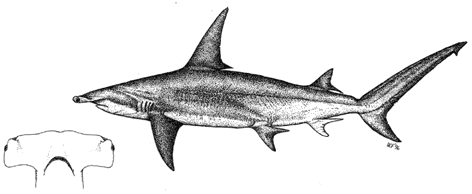Great Hammerhead Shark (Sphyrna mokarran)

(Rüppell, 1837)
| Fr: |
Grand requin-marteau |
| Sp: |
Cornuda gigante |
| It: |
Pesce martello maggiore |
| Ma: |
N/A |
Diagnosis
A large or very large (to over 500 cm) distinctive
hammerhead shark with an angular head measuring 23 to 27% of TL; its
anterior margin conspicuously straight and with a shallow median
indentation. Tooth count 17 on each side of upper jaw; 16 or 17 in
lower (discounting small symphyseals); teeth strongly serrated.
First dorsal fin noticeably tall, with an acute, pointed apex and
strongly falcate in shape; its origin opposite or just posterior to
the pectoral axil and free rear tip not extending rearwards to above
the pelvic fin origins. Posterior margins of pelvic fins concave and
strongly falcate. Second dorsal fin fairly tall compared to
congeners, its height 4.7-6.5% of TL with its posterior margin
concave and the inner margin rather short, equating to about the fin
height; free rear tip not extending to the precaudal pit. Anal fin
marginally larger, strongly concave and originating anterior to the
second dorsal origin. Pectoral fins moderately falcate in shape,
their anterior margins measuring 13.4 to 18.4% of TL. Dorsal colour
dark brown-grey or bronzy-grey, fading to white ventrally. Ventral
apices of pectoral fins plain, not dusky; apex of second dorsal fin
somewhat dusky in juveniles.
Size
Maximum perhaps in excess of 550cm and possibly over 600cm; most
adults to 350-450cm TL; size at birth ca. 65 cm. First Mediterranean
example measured ca. 300 cm and weighed ca. 120kg (Boero &
Carli, 1977).
Status and Distribution
Mediterranean Sea: Very rare; occasional reliable reports
originating from the North African coast between Gibraltar and
Tunisia; also Ionian Sea and Sicilian Channel but
misidentification with large S. zygaena very possible
in these fisheries; first regionally-recorded capture was
comparatively recent, from the Gulf of Genova at Camogli (Liguria,
Italy) in September 1969. Probably more cosmopolitan in the
Mediterranean as nomads and liable to be caught anywhere in the
region, particularly off more southern coasts.
Biology
A large, voracious species - and one of the largest predatory
sharks - occuring both as a coastal and semi-oceanic pelagic
inhabitant of continetal and insular shelves; ranging from the
surfline to well offshore at depths from the surface down to 80m or
greater. Great hammerheads are highly nomadic, with poleward
summertime migrations in parts of their global range. The origin of
these sharks within Mediterranean waters may be from either the
Atlantic ocean off NW Africa (where they are caught sporadically off
the coast from Senegal northwards) or even conceivably (albeit much
less probable) from the Red Sea as Suez Canal migrants, rather like
Carcharhinus melanopterus. They are predators upon a wide
variety of (primarily demersal) bony fish and elasmobranchs,
particularly groupers and dasyatid stingrays (a favoured prey-item,
consumed complete with tail-spines), but also jacks, clupeids and
flatfish; other elasmobranch prey included smoothhounds
(Mustelus spp.), skates, guitarfish and Rhinoptera spp;
invertebrates taken by these sharks include crabs and cephalopods
(squid). Reproduction is viviparous, with a yolk-sac placenta;
litter-sizes range between 6 - 42 young. Gestation period is 11
months. Females mature at ca. 210-250cm and males at ca. 225-269cm.
The Shark Trust, 36 Kingfisher Court, Hambridge Road, Newbury, Berkshire, RG14 5SJ, UK.
Tel(+44) 01635 551150, Fax(+44) 01635
550230
|